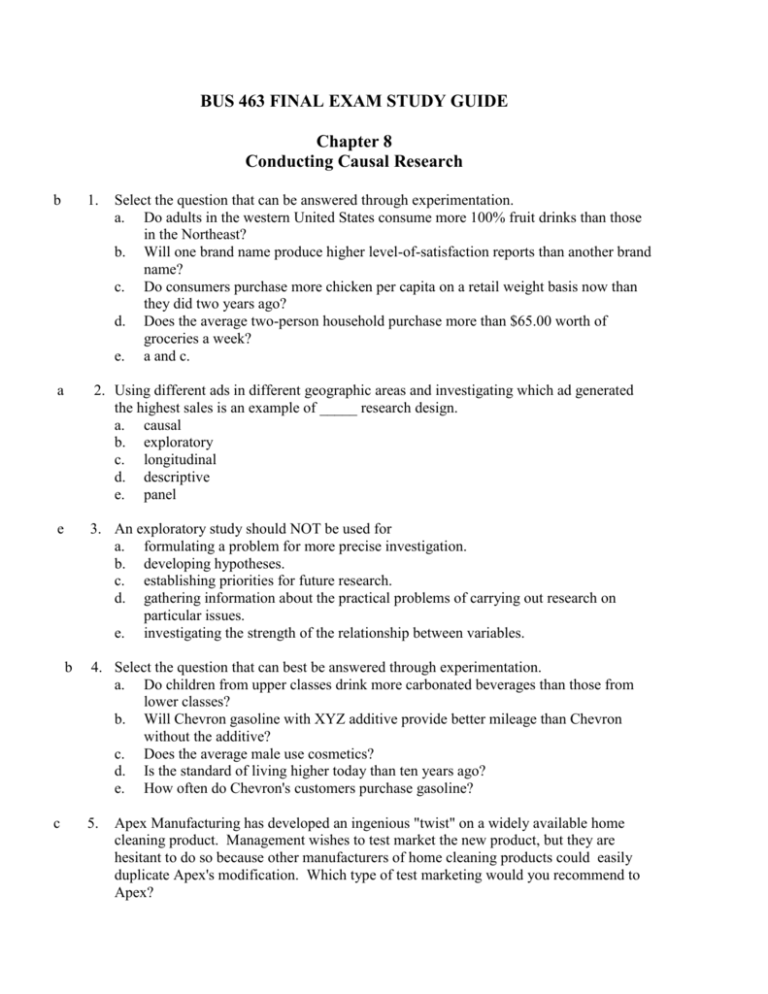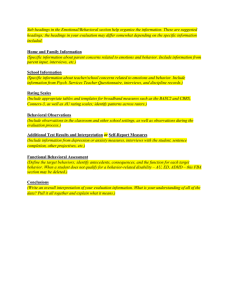Chapter 12
advertisement

BUS 463 FINAL EXAM STUDY GUIDE Chapter 8 Conducting Causal Research b 1. Select the question that can be answered through experimentation. a. Do adults in the western United States consume more 100% fruit drinks than those in the Northeast? b. Will one brand name produce higher level-of-satisfaction reports than another brand name? c. Do consumers purchase more chicken per capita on a retail weight basis now than they did two years ago? d. Does the average two-person household purchase more than $65.00 worth of groceries a week? e. a and c. a 2. Using different ads in different geographic areas and investigating which ad generated the highest sales is an example of _____ research design. a. causal b. exploratory c. longitudinal d. descriptive e. panel e 3. An exploratory study should NOT be used for a. formulating a problem for more precise investigation. b. developing hypotheses. c. establishing priorities for future research. d. gathering information about the practical problems of carrying out research on particular issues. e. investigating the strength of the relationship between variables. b c 4. Select the question that can best be answered through experimentation. a. Do children from upper classes drink more carbonated beverages than those from lower classes? b. Will Chevron gasoline with XYZ additive provide better mileage than Chevron without the additive? c. Does the average male use cosmetics? d. Is the standard of living higher today than ten years ago? e. How often do Chevron's customers purchase gasoline? 5. Apex Manufacturing has developed an ingenious "twist" on a widely available home cleaning product. Management wishes to test market the new product, but they are hesitant to do so because other manufacturers of home cleaning products could easily duplicate Apex's modification. Which type of test marketing would you recommend to Apex? a. b. c. d. e. controlled test marketing standard test marketing simulated test marketing forced-distribution test marketing electronic test marketing Based on the data below, answer the next two questions. BOUGHT AT t1 A B A 110 50 BOUGHT B 50 130 C 35 20 AT t2 Total 195 200 c 6. Which brand was the most popular at time, t1? a. A b. B c. C d. The three brands were equally popular. e. It is impossible to tell. e 7. How many people switched brands between time t1 and t2? a. 105 b. 130 c. 160 d. 240 e. 290 C 80 55 95 Total 240 235 150 230 625 Chapter 9 Collecting Primary Data a 1. Which of the following is NOT a demographic or socioeconomic characteristic? a. a feeling towards a brand b. marital status c. social class d. gender e. income b 2. Which of the following is a life-style characteristic? a. social class b. interests c. attitudes d. home ownership e. age d 3. If a researcher is interested in investigating whether or not consumers like a new packaging method for a particular product, the researcher should focus on measuring a. motivation. b. intention. c. behavioral goals. d. attitude. e. personality. e 4. Which of the following can be used to measure knowledge of an advertisement? a. unaided recall b. aided recall c. recognition d. a and b e. all of the above a 5. In the context of marketing research, a consumer's anticipated or planned future behavior is referred to as a. intention. b. motivation. c. goal orientation. d. need satisfaction. e. life-style. b 6. Which of the following is an example of the observation method of collecting primary data? a. administering a questionnaire to shoppers in a supermarket b. recording the amount of time a shopper stops in front of a point-of-purchase display c. asking shoppers which brand they noticed first in a shelf display d. conducting a telephone survey to determine which brands of detergent are purchased by mothers with young children e. using a tape recorder to gather shopper impressions of a new store layout design c 7. Which of the following types of primary data can be measured by observation? a. attitudes and opinions b. motivations and present behavior c. gender and present behavior d. social class and gender e. motivations and intentions Chapter 10 Collecting Information by Communication a 8. Questions that give the respondent no indication of the true purpose of the research project are known as a. disguised questions. b. confounded questions. c. structured questions. d. undisguised questions. e. unstructured questions. c 9. The responses as well as questions are standardized in a. an unstructured-disguised questionnaire. b. an unstructured-undisguised questionnaire. c. a structured-undisguised questionnaire. d. a depth interview. e. a focus group. d 10. After John purchased his new car, the car dealer sent him a new owner satisfaction survey, which consisted of several statements about his car, which John was to indicate agreement or disagreement with by checking the appropriate boxes. This survey is a. unstructured-undisguised. b. structured-undisguised. c. sentence completion. d. structured-undisguised. e. word association. b 11. Unstructured-disguised questionnaires lie at the heart of what has come to be known as a. Thematic Apperception Tests. b. motivation research. c. storytelling. d. projective methods. e. word association. c 12. If a respondent hesitates but then responds when taking a word association test, it is taken to indicate a. that the word is unfamiliar. b. that the respondent's involvement with the word blocks the response. c. that the respondent is emotionally involved in the word so that he searches for an acceptable response. d. that the theory of impaired cognitive emotions is operating. e. there is no meaning attached to such hesitation. c 13. Which of the following uses the projective method? a. fixed-alternative questionnaire b. depth interview c. sentence completion d. telephone interview e. none of the above use the projective method b 14. Which of the following are NOT projective techniques? a. sentence completion tasks b. depth interviews c. word association tasks d. story telling e. Thematic Apperception Tests a 15. The problem of nonresponse due to refusals to participate is a. usually lower with personal interviews than with either telephone interviews or mail-administered questionnaires. b. usually lower with mail questionnaires than with telephone or personal interviews. c. usually lower with telephone interviews than with mail questionnaires or personal interviews. d. usually the same no matter what communication method is used. e. none of the above are true. b 16. Which of the following is an accurate statement with regard to personal interviews? a. In general they tend to be the least expensive per completed contact. b. As the number of interviewers increases, so do problems of interviewer-related variations in responses. c. It takes as long to get replies from a small sample as from a large sample. d. Interviewer-induced bias is minimal. e. They are less costly than telephone interviews. a 17. Which of the following data collection methods is most versatile? a. personal interviews. b. e-mail surveys. c. fax surveys. d. mail surveys. e. phone interviews. Chapter 13 Designing the Data Collection Form d 18. Which of the following do NOT impact an individual's ability to remember information sought by a researcher? a. the presence or absence of stimuli that assist in remembering an event b. the importance of the event to be remembered c. the length of time since the event to be remembered occurred d. all of the above impact an individual's ability to remember information e. b and c only e 19. One method of handling potentially embarrassing questions uses a. branching questions. b. the telescoping technique. c. d. e. fixed alternatives. item nonresponse. the randomized-response model. b 20. Which of the following statements is INCORRECT with respect to the randomized- response model? a. The respondent answers one of several paired questions at random. b. The interviewer knows which question is being answered by the respondent. c. It is not possible to link responses to the paired questions with other responses such as demographic characteristics. d. The respondent is less likely to refuse to answer or to answer untruthfully if the randomized-response model is used. e. Answers to sensitive questions are more likely to be truthful. b 21. In the randomized response model, which of the following questions would NOT be appropriate for pairing with this question "Have you ever shoplifted?" a. "Were you born prior to 1960?" b. "Do you cheat on your income taxes?" c. "Is your birthday in September?" d. "Are you male or female?" e. All of the above could be paired with the question. d 22. A fixed-alternative question with three possible responses is a. an open-ended question. b. a dichotomous question. c. a threatening question. d. a multichotomous question. e. a classification question. c 23. What is wrong with this question? "What is your annual income?" (Please check) ___ $10,000-$25,000 ___ $25,000-$40,000 ___ $40,000-$55,000 ___ $55,000-$70,000 a. The categories are not of equal ranges. b. The alternatives are not realistic. c. The categories are not mutually exclusive. d. The categories are too broad. e. The categories are too narrow. a 24. "Order bias" refers to a. the potential for responses to be affected by the sequence in which the alternatives are presented. b. the tendency of individuals to order their thoughts in a chronological manner. c. the desire of individuals to live in an "ordered world." d. e. the tendency of respondents to follow literally the instructions given by an interviewer. the tendency of respondents to complete questions in the order they are presented by an interviewer. a 25. A split-ballot refers to a. the practice of using different phrasing or different orders for the alternatives on subsets of questionnaires to combat order bias. b. the practice of splitting the questionnaire responses in half for more accurate analysis. c. an administrative procedure in state elections. d. averaging in scale construction. e. none of the above. d 26. "Do you own your own home?" Yes __ No __ The above is an example of a __ question. a. multichotomous b. bi-polar c. free response d. dichotomous e. projective c 27. The question, "Do you exercise often? seldom? sometimes?" is a. leading. b. concrete. c. ambiguous. d. contains an implied alternative. e. contains an implied assumption. d 28. The question, "Do you feel the government should be forced to stop picking our pockets with excessive taxes and return a portion of the taxes collected to taxpayers?" a. is leading. b. contains an implicit alternative. c. is double-barreled. d. a and c. e. none of the above. b 29. The question "Do you think gun control legislation is an effective way to end the senseless slaughter rampant in the inner cities?" __ Yes __No is an example of a. a double-barreled question. b. a leading question. c. an ambiguous question. d. an implied alternative. e. a multichotomous response. c 30. The question "Are you in favor of the free-choice policy for determining which school your child attends?" is an example of a. an implicit alternative. b. a double-barreled question. c. an implicit assumption. d. a leading question. e. a classification question. d 31. "Please indicate your opinion on congressional spending and tax reform." This question a. would be a good opening question for a survey. b. uses the funnel approach. c. contains an implicit assumption. d. is double barreled. e. is dichotomous. c 32. The question in a restaurant survey, "What is your evaluation of the speed and courtesy of your waitperson?," is an example of a. an unambiguous question. b. a branching question. c. a double-barreled question. d. a generalization. e. a redundant question. a 33. The question, "How would you judge the price and quality of this product?" is a. double-barreled. b. leading. c. contains an implied alternative. d. contains an implied assumption. e. forces generalization on the part of the respondent. c 34. The "funnel approach" refers to a. asking simple questions first. b. a method of data analysis. c. successively narrowing the focus of related questions. d. using a funnel as a visual aid when asking sensitive questions in a personal interview. e. successively broadening the scope of related questions. e 35. A pretest of the questionnaire is useful for all of the following reasons EXCEPT a. to assess individual questions. b. to assess sequence of questions. c. to determine interviewer problems with questions. d. to determine if data collected is suitable for analysis. e. a pretest is useful for all of the above reasons. Chapter 12 SCALES OF MEASUREMENT and Measuring Attitudes, Perceptions, and Preferences e 1. Attitude represents a. a predisposition to respond to an object. b. behavior toward an object. c. a person's ideas, convictions, or liking for a specific object or idea. d. all of the above. e. a and c only. e 2. Marketers are concerned with the attitudes of a. consumers. b. dealers. c. sales representatives. d. a and b. e. a, b, and c. e 3. Igloo Ice Cream Shop introduced a new berry-flavored milkshake, but the item has been an unsuccessful menu addition, since few customers choose to order the berry shake. The manager assumes that the consumer attitude toward the product is negative by using which approach of attitude scaling? a. self-report b. indirect techniques c. physiological reactions d. performance of objective tasks e. observation of behavior e 4. To assess attitudes toward seatbelt laws, researchers asked respondents to memorize facts pertaining to both sides of the issue, such as the number of fatal accidents where seatbelts were not used and the various injuries that can be caused by seatbelts worn in car wrecks. This technique of attitude scaling is called a. observation of behavior. b. self-report. c. indirect technique. d. physiological reaction. e. performance of objective tasks. c 5. The following excerpt from a survey uses which type of scale? Neither Strongly Agree Nor Strongly Disagree Disagree Disagree Agree Agree 1. The restaurant has a clean atmosphere. 2. The restaurant serves quality food. 3. The restaurant has reasonable prices. 4. The restaurant has friendly service. a. b. c. d. e. sematic-differential staple Likert constant-sum none of the above c 6. The __________ adjective pair "helpful-unhelpful" is used in a __________ scale. a. anchored, summated-ratings b. anchored, semantic differential c. bipolar, semantic-differential d. bipolar, snake e. none of the above b 7. The use of a "snake diagram" is associated with a. Likert scales. b. semantic-differential scales. c. conjoint analysis. d. Stapel scales. e. constant-sum scales. e 8. The Stapel scale is a. a modification of the semantic differential which uses bipolar pairs, has numbered points on the scale, and uses 8 scale positions. b. a modification of the semantic differential which frees the researcher from the need for item analysis. c. d. e. a modification of the semantic differential which is unipolar, has 7 scale positions, and points on the scale are numbered. an eight-point rating scale. unipolar, has 10 scale positions, and points on the scale are numbered. d 9. A technique in which some of the items on a multi-item scale are written so that the most positive responses are at the opposite end of the scale from where they would normally appear is a. comparative scaling. b. opposition biasing. c. haloing. d. reverse scaling. e. none of the above. b 10. In which situation would the addition of a “don’t know” response be most advisable? a. A retail store randomly selects names from the customer database. b. A department store randomly selects respondents from the local telephone directory. c. A convenience store hands out questionnaires to every fifth customer. d. a and b. e. a, b, and c. 11. A research effort requires the researcher to use numbers to identify or categorize particular objects. The type of scale the researcher will use is a ratio. . b ordinal. . c interval. . d nominal. . e conscious. . ANS: D 12.Which of the following is(are) permissible measure(s) of central tendency with ratio scales? a Arithmetic mean, median and the mode . b Geometric mean . c Median and mode . d Both a and b. . e . a, b, and c. ANS: D 13. Which of the following statements is INCORRECT with respect to a nominally classified variable? a Counting is the only permissible operation. . b The median is a permissible measure of central tendency. . c The only property conveyed by the number is identity. . d When members of a sample have been classified along a nominal scale, it is . possible to say what percentage of the sample is classified a certain way. e The mode is a permissible measure of central tendency. . ANS: B 14.The ordinal scale represents a higher level of measurement than the nominal scale in that a the assigned numerals serve to identify the objects. . b the magnitude of the differences in the objects is shown. . c the assigned numerals represent the order as well as identifying the object. . d it has a natural zero. . e it has an arbitrary zero. . ANS: C 15.The notion that equal differences among scores represent equal differences in the amount of the attribute possessed by the object applies to ____ scales. a nominal . b ordinal . c interval . d ratio . e interval and ratio . ANS: E 16.Which of the following about interval scales is FALSE? a An interval scale exhibits the property of order. . b Absolute magnitudes cannot be compared using an interval scale because the zero . point is established arbitrarily. c The number of years the respondent has lived at a particular address is an . example of an interval scale. d Both a and b. . e a, b, and c. . ANS: C





